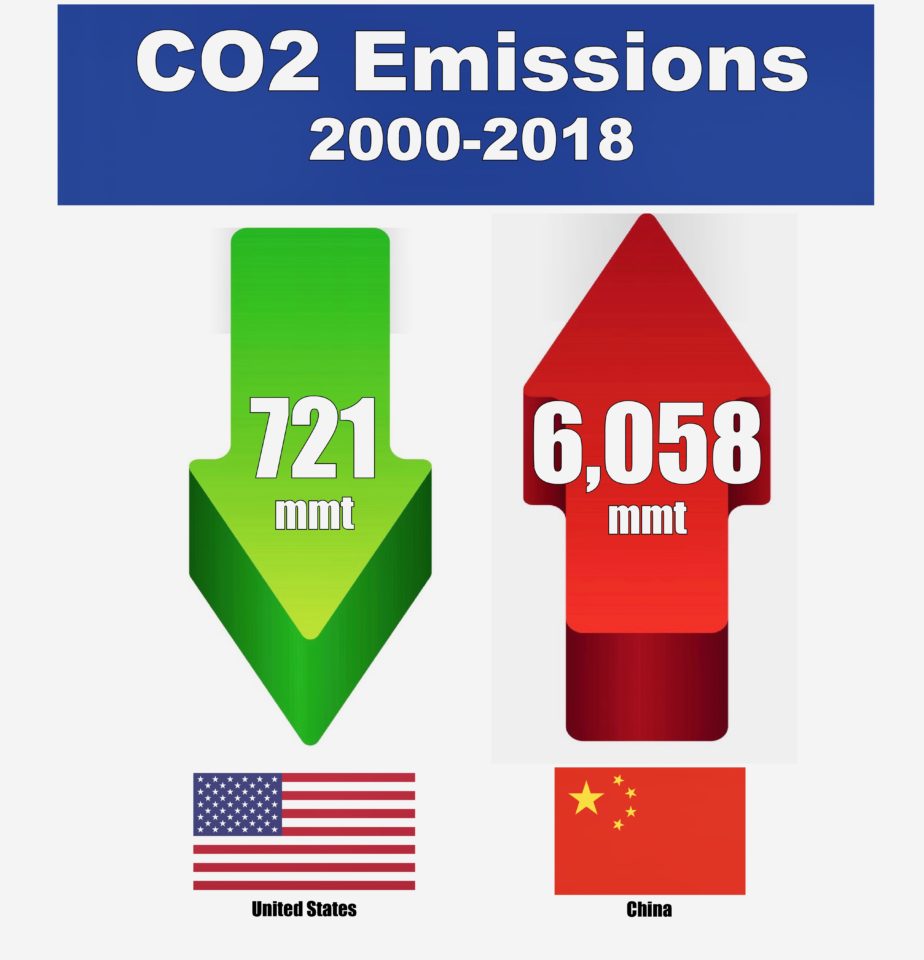Paris Paradox: U.S. Leading in CO2 Reductions This Century While China’s Emissions Have Nearly Tripled
The United States’ withdrawal from the Paris climate agreement has generated considerable angst from environmental activists. But despite all the vitriol the Trump administration’s decision has yielded, America is more realistically positioned to meet Paris carbon dioxide reduction targets than virtually every nation that signed the non-binding agreement, proving once again that actions speak louder than words.
Case in point: China.
The Paris Agreement’s most prominent signatory has seen its CO2 emissions increase 180 percent since 2000, according to BP’s recently released 2019 Statistical Review of World Energy. No, that is not a typo – China’s CO2 emissions have nearly tripled from 3,361 million metric tons (mmt) in 2000 to 9,419 mmt last year.
In sharp contrast, the United States has led the world in CO2 reductions this century, slashing emissions 721 mmt since 2000.

The United States has reduced energy-related CO2 emissions 14 percent since 2005, putting us in position to meet Paris reduction targets of 26 to 28 percent below 2005 levels by 2025.
As former New York City mayor and environmental activist Michael Bloomberg recently noted,
“We’re half way there already and there’s seven years left to go.”
The primary reason for this success is increased natural gas use, not renewable energy mandates similar to what would be imposed by a binding version of the Green New Deal, or what has been implemented, and failed, in Germany.
While supposedly “greener” European Union nations are coming up short of their Paris commitments, United Nations Energy Programme chief Erik Solheim has noted, “In all likelihood, the United States of America will live up to its Paris commitment, not because of the White House, but because of the private sector.”
Indeed, private sector innovation has made natural gas so abundant and affordable that the clean-burning fuel has quickly become the top source of U.S. power generation.
As a result, a 2018 U.S. Energy Information Administration (EIA) report shows that growth in natural gas consumption can be credited for 61 percent of the total 3.86 billion metric tons of electric generation CO2 reductions since 2005. Moving forward, the EIA projects U.S. energy-related CO2 emissions will decline this year (1.6%) and in 2020 (1%), while a 2018 analysis by researchers from Carnegie Mellon University (CMU) concludes that continued low natural gas prices – which are highly likely thanks to the shale revolution — could “put the country on the path to meeting the long-term goals” of the Paris Climate Accords.
Contrary to the oft-repeated “Keep It In the Ground” narrative, the U.S. oil and natural gas boom has actually helped the United States establish itself as the world leader in greenhouse gas reductions. In contrast, China — which has all sorts of gushing press for its renewable energy capacity additions — is building 300-plus coal power plants while watching its CO2 emissions skyrocket.
The United States all-of-the-above, market-driven model for greenhouse gas reductions has not only been effective, it is far more realistic than what Green New Deal advocates are proposing. For all the hype about a 100 percent renewable energy conversion, oil and natural gas will be needed for decades to come. Even under a Paris Agreement 100 percent compliance scenario, 48 percent of global energy will still come from oil and natural gas in 2040. This isn’t an industry talking point. It’s reality.
Which begs the question: Why is Michael Bloomberg – who once praised natural gas’ environmental benefits – now committing $500 million of his own fortune to shut down natural gas power plants when they are the No. 1 reason the U.S. leads the world in CO2 reductions this century?
